Yamaha Motor Co., Ltd. is a Japanese mobility manufacturer that produces motorcycles, motorboats, outboard motors, and other motorized products. The company was established in the year 1955 upon separation from Nippon Gakki Co., Ltd. and is headquartered in Iwata, Shizuoka, Japan. The company conducts development, production and marketing operations through 109 consolidated subsidiaries as of 2012.
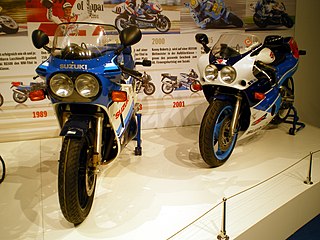
Suzuki GSX-R is a series of sports motorcycles made by Japanese automotive manufacturer Suzuki since 1984.
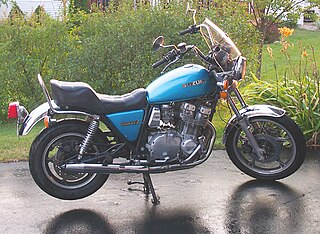
The Suzuki GS series was Suzuki Motor Corporation's first full range of 4-stroke powered road motorcycles, having previously almost exclusively manufactured 2-stroke machines. Suzuki had produced the 4-stroke Colleda COX 125cc and 93cc 4-stroke single-cylinder machines in 1955 however the rest of Suzuki's production from 1952 to 1976 had been increasingly sophisticated two-stroke road machines, whose ultimate expression was the 750cc 3-cylinder water-cooled GT750.
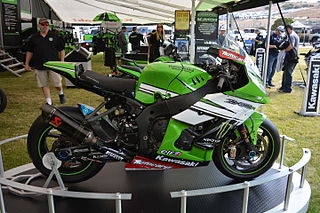
The Kawasaki Ninja ZX-10R is a motorcycle in the Ninja sport bike series from the Japanese manufacturer Kawasaki, the successor to the Ninja ZX-9R. It was originally released in 2004 and has been updated and revised throughout the years. It combines an ultra-narrow chassis, low weight, and radial brakes. In 2004 and 2005 the ZX-10R won Best Superbike from Cycle World magazine, and the international Masterbike competition.
"Genesis" is Yamaha's marketing name for a range of innovative, high-performance multi-valve four-stroke motorcycle engines. The flexible design of the engine allowed Yamaha to use it on a variety of configurations, from sport bikes to outboard engines.
The GSX Series is Suzuki's range of sport touring motorcycles powered by four-valve per cylinder four-stroke engines. The first GSX models were introduced in 1980 and represented the next step in Suzuki's four-stroke road bike range after the two-valve GS Series.
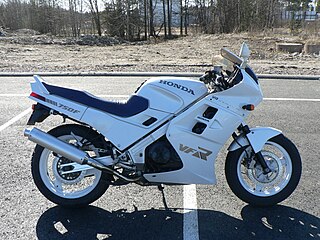
The Honda VFR750F is a motorcycle manufactured by Japanese automobile manufacturer Honda from 1986 to 1997. The motorcycle is a very sporty sport tourer, and is powered by a 750 cc (46 cu in) V4 engine developed from the earlier VF750F models. The VFR was announced in 1986, after an initial press viewing at the 1985 Bol d'Or.
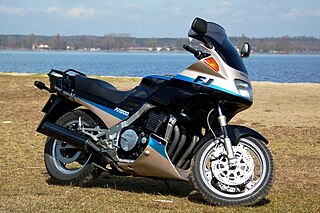
The Yamaha FJ1100 and FJ1200 are sport touring motorcycles that were produced by Yamaha between 1984 and 1996.

The Honda CBR1000RR, marketed in some countries as the "Fireblade", is a 999 cc (61.0 cu in) liquid-cooled inline four-cylinder superbike, introduced by Honda in 2004 as the 7th generation of the CBR series of motorcycles that began with the CBR900RR in 1992.

The Yamaha XS Eleven motorcycle, also called XS 1100 and XS 1.1, is a Japanese standard produced from late 1977 (MY1978) to 1983, powered by an air-cooled 1,101 cc (67.2 cu in) 4-stroke, DOHC inline four-cylinder engine mounted transversely in a duplex cradle frame with swingarm rear suspension, shaft drive, and telescopic forks.
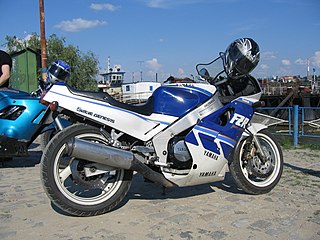
The Yamaha FZR1000 is a motorcycle produced by Yamaha from 1987 to 1995. Classed as a sports motorcycle.
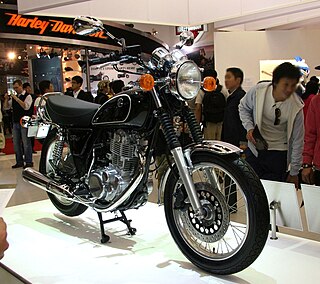
The Yamaha SR400 (1978–2021) and SR500 (1978–1999) are single-cylinder, air-cooled, two-passenger motorcycles manufactured in Japan by Yamaha Motor Company as a street version of the Yamaha XT500, with a standard riding posture and styling resembling the Universal Japanese Motorcycles of the 1970s. The two models differ by their engines: the SR400 engine has a lower displacement, achieved with a different crankshaft and shorter piston stroke and both models feature only kickstarting, i.e., no electric starter.
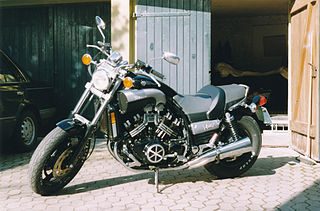
The Yamaha V-Max, is a cruiser motorcycle produced by Yamaha from 1985 through 2020. Known for its 70° V4 engine, shaft drive, and distinctive styling, the V-Max was discontinued following the 2020 model year.
Motorcycle components and systems for a motorcycle are engineered, manufactured, and assembled in order to produce motorcycle models with the desired performance, aesthetics, and cost. The key components of modern motorcycles are presented below.
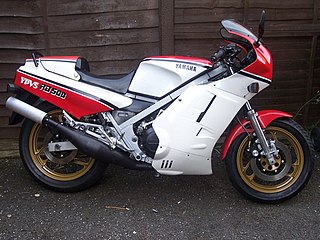
The Yamaha RD500LC is a high-performance, two-stroke sports motorcycle, also known as the RZ500 in Canada and Australia. A lightened but detuned version known as the RZV500R was developed for the Japanese home market. Strict United States Environmental Protection Agency regulations meant that the RZ500 was not available for sale in that country. Produced for a short period between 1984 and 1986 it has become a sought after collector's machine.

The Suzuki TU250— marketed also as the TU250X, ST250 and ST250 E-Type — is a single-cylinder, air-cooled lightweight street bike manufactured by Suzuki across two generations from 1994 to 2019.

The Moto Guzzi Le Mans is a sports motorcycle first manufactured in 1976 by Italian company Moto Guzzi. It was named after the 24-hour motorcycle endurance race at Le Mans in France. The Le Mans designation was first used for an 850 prototype, based on the V7, displayed at Premio Varrone in late 1972.
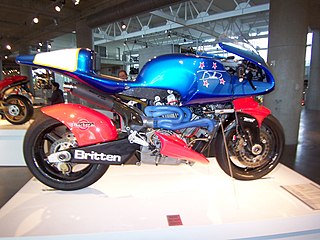
The Britten V1000 is a handbuilt race motorcycle designed and built by John Britten and a group of friends in Christchurch, New Zealand during the early 1990s. The bike went on to win the Battle of the Twins in Daytona International Speedway's Daytona Bike Week festivities in the United States and set several world speed records.

The Suzuki A100 is a Japanese motorcycle from the Suzuki Motor Corporation with production starting in 1966.Similar models were produced by Yamaha and Kawasaki with the YB100 & KH100 models, also with a single-cylinder two-stroke engine and rotary valve being examples.

The Norton Model 88 Dominator, also originally known as the Dominator De Luxe was a 500 cc vertical twin motorcycle manufactured by the British Norton Motorcycle Company from 1952 to 1966. It was the first of Norton's motorcycles to use the featherbed frame, which established Norton's reputation of producing fine handling machines. The 88 used the Bert Hopwood designed engine that was first fitted to the Model 7 and was initially for export only. It became available on the home market in 1953. Norton were a small manufacturer at the time and without the economies of scale the model was expensive compared to other manufacturer's equivalent machines. The 88 retailed for 20% more than the contemporary Triumph Speed Twin and was dearer than the 650 cc Triumph Thunderbird.






















